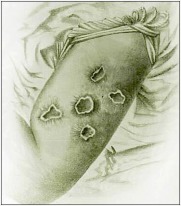Revolution
Inoculation provided a safer way to defend oneself from smallpox by providing further immunity to the disease and limited physical damage.
"They all had Smallpox at the usual Time, and of the distinct Sort: Mr Dorr was full, his Pock inflam'd, and his Fever too high: This, with his great Concern for his children the continual Noise, the Want of Sleep, made the poor Gentleman almost distracted, which obliged me to bleed him twice, to apply Epispastics, use Anodines, Etc. at the turning of the Small-Pox Inoculated in New England."
- Doctor Zabdiel Boylston
- Doctor Zabdiel Boylston
- During the earlier inoculations, the technique had yet to be perfected
- Resulted in a few severe cases
- These cases were often used in an argument against inoculation
- Success rate of the vaccine was quite high considering its relative newness
- Graphs contain data gathered from post-epidemic Boston in 1721
- As shown, those who were inoculated had a much better chance of surviving than those who did not
- Most physicians of the time argued that it was better to remain unprotected
- They feared that the mild case of smallpox which follows an inoculation could trigger an epidemic among the non-inoculated population.




